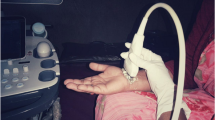Abstract
Purpose
The purpose of the study was to validate the reliability of quantitative intraneural enhancement patterns by using contrast-enhanced ultrasonography (CEUS).
Methods
Nine asymptomatic wrists underwent a total of three CEUS examinations each conducted at 1-month intervals. The CEUS enhancement pattern of median nerves was quantitatively evaluated. The area under the time–intensity curve was calculated by placing the regions of interest at the proximal, center, and distal regions of the median nerve. An intra-class correlation coefficient for intra-observer, inter-observer, and inter-examination reproducibility was calculated.
Results
The intra- and inter-observer reproducibility was almost perfect. Inter-examination reproducibility of the proximal, center, and distal regions was 0.891, 0.614, and 0.535, respectively. In this study, we found that the reproducibility of the distal and center regions of the median nerve in the carpal tunnel was lower than that of the proximal region.
Conclusion
High intra-observer, inter-observer, and inter-examination reproducibility of CEUS was obtained in the evaluation of the intraneural enhancement pattern when the region of interest was placed in the proximal region of the median nerve.



Similar content being viewed by others
References
Lundborg G, Dahlin LB. The pathophysiology of nerve compression. Hand Clin. 1992;8:215–27.
Sugimoto H, Miyaji N, Ohsawa T. Carpal tunnel syndrome: evaluation of median nerve circulation with dynamic contrast-enhanced MR imaging. Radiology. 1994;190:459–66.
Joy V, Therimadasamy AK, Chan YC, et al. Combined Doppler and B-mode sonography in carpal tunnel syndrome. J Neurol Sci. 2011;308:16–20.
Ghasemi-Esfe AR, Khalilzadeh O, Vaziri-Bozorg SM, et al. Color and power Doppler US for diagnosing carpal tunnel syndrome and determining its severity: a quantitative image processing method. Radiology. 2011;261:499–506.
Mallouhi A, Pulzl P, Trieb T, et al. Predictors of carpal tunnel syndrome: accuracy of gray-scale and color Doppler sonography. Am J Roentgenol. 2006;186:1240–5.
Mohammadi A, Ghasemi-Rad M, Mladkova-Suchy N, et al. Correlation between the severity of carpal tunnel syndrome and color Doppler sonography findings. Am J Roentgenol. 2012;198:W181–4.
Kudo M, Hatanaka K, Maekawa K. Newly developed novel ultrasound technique, defect reperfusion ultrasound imaging, using sonazoid in the management of hepatocellular carcinoma. Oncology. 2010;78(Suppl 1):40–5.
Hatanaka K, Kudo M, Minami Y, et al. Sonazoid-enhanced ultrasonography for diagnosis of hepatic malignancies: comparison with contrast-enhanced CT. Oncology. 2008;75(Suppl 1):42–7.
Funakoshi T, Iwasaki N, Kamishima T, et al. In vivo visualization of vascular patterns of rotator cuff tears using contrast-enhanced ultrasound. Am J Sports Med. 2010;38:2464–71.
Funakoshi T, Iwasaki N, Kamishima T, et al. In vivo vascularity alterations in repaired rotator cuffs determined by contrast-enhanced ultrasound. Am J Sports Med. 2011;39:2640–6.
Sontum PC. Physicochemical characteristics of Sonazoid, a new contrast agent for ultrasound imaging. Ultrasound Med Biol. 2008;34:824–33.
Phalen GS. The carpal-tunnel syndrome. Seventeen years’ experience in diagnosis and treatment of six hundred fifty-four hands. J Bone Joint Surg Am. 1966;48:211–28.
Kobayashi S, Hayakawa K, Nakane T, et al. Visualization of intraneural edema using gadolinium-enhanced magnetic resonance imaging of carpal tunnel syndrome. J Orthop Sci. 2009;14:24–34.
Rotman MB, Enkvetchakul BV, Megerian JT, et al. Time course and predictors of median nerve conduction after carpal tunnel release. J Hand Surg Am. 2004;29:367–72.
Impink BG, Gagnon D, Collinger JL, et al. Repeatability of ultrasonographic median nerve measures. Muscle Nerve. 2010;41:767–73.
Aleman L, Berna JD, Reus M, et al. Reproducibility of sonographic measurements of the median nerve. J Ultrasound Med. 2008;27:193–7.
Buchberger W, Schon G, Strasser K, et al. High-resolution ultrasonography of the carpal tunnel. J Ultrasound Med. 1991;10:531–7.
Buchberger W, Judmaier W, Birbamer G, et al. Carpal tunnel syndrome: diagnosis with high-resolution sonography. Am J Roentgenol. 1992;159:793–8.
Duncan I, Sullivan P, Lomas F. Sonography in the diagnosis of carpal tunnel syndrome. Am J Roentgenol. 1999;173:681–4.
Fullerton PM. The effect of ischemia on nerve conduction in the carpal tunnel syndrome. J Neurol Neurosurg Psychiatry. 1963;26:385–97.
Garland H, Bradshaw JP, Clark JM. Compression of median nerve in carpal tunnel and its relation to acroparaesthesiae. Br Med J. 1957;1:730–4.
Acknowledgments
The authors thank Mr. Hiroyuki Okuhara, Mr. Masashi Yamamoto, Mr. Nozomu Murakami, and Ms. Tomoka Kawaguchi for the acquisition and analysis of electrophysiological data.
Conflict of interest
None.
Human rights statements and informed consent
All procedures followed were in accordance with the ethical standards of the responsible committee on human experimentation (institutional and national) and with the Helsinki Declaration of 1975, as revised in 2008 (5). Informed consent was obtained from all patients for being included in the study.
Author information
Authors and Affiliations
Corresponding author
About this article
Cite this article
Ishizaka, K., Nishida, M., Motomiya, M. et al. Reliability of peripheral intraneural microhemodynamics evaluation by using contrast-enhanced ultrasonography. J Med Ultrasonics 41, 481–486 (2014). https://doi.org/10.1007/s10396-014-0533-0
Received:
Accepted:
Published:
Issue Date:
DOI: https://doi.org/10.1007/s10396-014-0533-0




